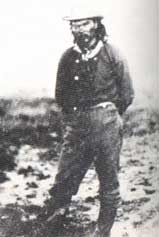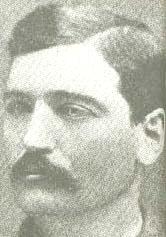Red River War
|
|
|
|
Billy Dixon, Heads Displayed on Gate at Adobe Walls and "Bat" Masterson |
The Kiowas next rode north to the Panhandle, picking up Satanta and his band along the way. Here they struck Lyman's Wagon Train. The warriors found themselves in a protractive battle but were eventually forced to break off their siege so that they could make roll call at the Anadarko Reservation and receive their allotments. Their bloodied weapons drew an officer's attention and tensions mounted as the braves ignored the officer's demand to surrender their arms. Fighting broke out when Comanche Chief Red Food executed a back flip off his horse, unloading his weapon as his feet hit the ground. Reinforcements arrived from Fort Sill the next day forcing the Comanches to retreat to their strongholds on the Staked Plains. The reservation Indians were now completely under the army's authority and forced to attend a daily roll call.
This included Satanta. His bugle was easily identifiable and proof of his participation in the Lyman siege. He was returned to Huntsville for parole violation. Hopelessly confined, the great war chief jumped to his death from an upper level prison window. His partner, Big Tree, eventually became a deacon in the reservation's Baptist church.
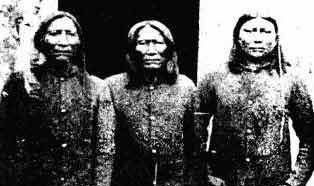
Prisoners destined to Fort Marion: Lone Wolf, Owl Prophet and White Horse.
Mackenzie's raid into the Palo Duro Canyon and the subsequent destruction of thousands of the Comanches ponies assured the defeat of the combined tribes on the Southern Plains. The natives refer to the army's activities during the following year as a rabbit hunt. Cavalry units chased the scattered, starving, horseless and sometimes shoeless bands until they submitted to reservation life. In 1875 Quanah saw a wolf walking toward Fort Sill and took it as a sign to surrender his Quahida's.
Thomas Battey, a Quaker school teacher, displayed a gadget called a stereoscope, with which his Kiowa and Comanche charges could view photographs. First he showed them mountain landscapes from Colorado familiar to even the young boys and girls. Then, he showed city scenes including buildings and trains, which startled the Kiowa chiefs who had not believed the stories told by their peers who had visited the United States over the previous decades. Chief Sun Boy cried "You think they're all lies now? You still think all chiefs who've been to Washington are fools?"… "Look-see what a mighty, powerful people they are! We're fools! We don't know anything! We're just like wolves running wild on the plains!"
Kicking Bird was assigned the dubious task of turning over the warriors "most" responsible for the raids. The unfortunates were sent to Fort Marion in St. Augustine, Florida. Included were the Kiowas Lone Wolf, Owl Prophet, White Horse, Buffalo Bulls Entrails, Woman Heart and Eagle Chief. In addition, thirty-four Cheyenne, nine Southern Comanche, two Arapaho and one Caddo were sent. Owl Prophet publicly placed a curse on Kicking Bird, who died mysteriously within a few days.
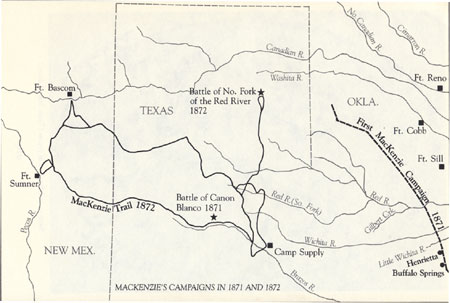
The Major Drives in the Panhandle and Northwest
During 1874, Comanche and Kiowa raids in Kansas, the Adobe Walls and Lost Valley fights, other raids and the exceedingly hostile attitude of Indians, were decisive factors in causing the government to make several major drives against the Indians; and in bringing to a close the bloody war that had been long waged upon the West Texas frontier. For years, the Texas Panhandle and elsewhere was a hotbed of human tigers, and from here the wild men depredated in all directions. Consequently the department arranged for several major campaigns to be made for the purpose of disarming these Indians and placing them on reservations. Orders were issued that columns of soldiers simultaneously march from the north, south, east, and west, toward the Panhandle of Texas.
Such movements were contemplated to surround the Indians in this territory during the closing days of summer and severe winter weather, and thereby force them to surrender.
Brigadier-General Augur, in his reports, stated, "Col. MacKenzie, with one column, was to operate from his old supply camp, on the fresh fork of the Brazos, and to draw his supplies from Ft. Griffin, distant 120 miles. Col. MacKenzie was garrisoned with eight companies of his own regiment, 4 companies of the 10th Infantry, and 1, of the 11th Infantry. In addition, his forces were augmented by about 30 Indian scouts. Major W.R. Price, of the 8th Cavalry, received orders to move down the Canadian, from Ft. Bacon and Ft. Union, New Mexico, to join Col. Nelson A. Miles. Major Price's forces consisted of four companies of cavalry. Col. Nelson A. Miles, in command of eight companies of the Sixth Cavalry, four companies of the Fifth Infantry, and three small field guns, was ordered to move from Camp Supply, Indian territory, by the Antelope Hills, near which Major W.R. Price and his command were ordered to join Col. Nelson A. Miles. Major Price's forces consisted of four companies of cavalry, Col. Nelson A. Miles, in command of eight companies of the Fifth Infantry, and three small field guns, was ordered to move from Camp Supply, Indian Territory, by the Antelope Hills, near which Major W.R. Price and his command were ordered to join Col. Nelson A. Miles. Lt.-Col. Davidson with six companies of the Tenth Cavalry, and three companies of the 11th Infantry, and forty-four Indian scouts, was ordered to move up the Washita; and Lt. Col. Buell, with six companies of Cavalry, two companies of the Eleventh Infantry and about 30 Indian scouts, was ordered to operate from Ft. Sill between Col. R.S. MacKenzie and Lt. Col. Davidson. In the five different commands, there were approximately 3500 soldiers, and over 100 Indian scouts. It was planned for Col. Nelson A. Miles to strike first, and when the savages fled south, they were then to be encountered by the forces of Col. R.S. MacKenzie, who was moving toward the head-waters of the Brazos, from Ft. Concho, and who received his supplies from Ft. Griffin.
These forces had several engagements with the Indians, and on a number of occasions, detachments thereof, had numerous minor engagements.
A general idea of the movement of the various troops was given by Lt. Gen. P.H. Sheridan, in his report of October 1, 1874, as follows:
"On the twenty-first of July authority was received from the Department of the Interior, through the Secretary of War, to invade, if necessary, the special Indian reservations set aside for these Indians within the limits of Indian Territory, or, in other words, to punish them wherever they might be found. General Pope was then authorized to push his troops into the field and carry out this condition to the best of his ability.
"The result has been the organization of a column under Col. Nelson A. Miles, Fifth Infantry, which advanced against the Indians from Camp Supply, Ind. T. via Antelope Hills, and another column, under Major W.R. Price, Eight Cavalry, moved down the Canadian River from Forts Bascom and Union, New Mexico, to join Col. Miles, at or near the Antelope Hills.
"Col. Miles encountered the Indians near the headwaters of the Washita River and kept up a running fight for several days, the Indians steadily falling back until they reached the hills, eight miles from the Salt Fork of Red River where they made a bold stand, but were promptly attacked and routed, and pursued in a southwesterly direction across Main Red River and out on the Staked Plains, losing heavily in men, and animals, and baggage. Owing to a want of supplies Col. Miles was at length forced to abandon the pursuit and return to a point near Antelope Hills where supplies had been sent him. This train of supplies which met him at the point indicated, had been attacked by a large force of Indians, principally Kiowas from the Wichita Agency, while moving on the Washita River above the place, but had most gallantly and successfully defended by Capt. Lyman and Lt. Lewis with a small train-guard of about sixty men, Lt. Lewis received a severe wound in the action.
"Col. Miles has by this time, in all probability, resumed the pursuit of the tribes and in conjunction with the column of Col. MacKenzie, who is moving up from Texas toward the headwaters of Red River, almost to the very spot where Col. Miles has driven the Indians, and Lt. Col. Davidson, who has been moving with his command since the 10th of September up the Washita, together with Lt. Col. Buell, who is moving from Ft. Sill, up the main Red River, we may well anticipate lively times for these unruly Indians.
"All of these columns were pushed out much sooner than was desirable, especially that of Col. Miles and Major Price; but I deemed it necessary that we should take the field at once, to prevent hostile Indians from forcing out those of their tribes who had made up their minds to remain at peace, and, also, to prevent the accumulation of winter supplies from the buffalo herds. As these hostile Indians have their families and stock with them, and as Col. Miles has given them but little time to hunt for the last six or eight weeks, and as all of our columns are now in the field, we may hope for good results soon. Still the country is large, and it may take us until mid-winter to accomplish the object in view, namely, the definite settlement of Indian troubles in the Southwest forever.
"I respectfully differ with General Pope as to the chief causes of these Indian troubles, and attribute it to the immunity with which these tribes have been treated in all their raids into Texas for the past three years. Their reservations have furnished them supplies with which to make the raids, and shelterd them from pursuit when they returned with their scalps and plunder.
"There is no doubt that the advance of settlers and the operations of authorized surveying parties in the Indian Territory and Kansas, and also the buffalo-hunters at Adobe Walls, irritated them; but the business in which these parties were engaged made war an exceedingly undesirable thing for them. No man of close observation, it seems to me, can travel across the great plains from Nebraska and Wyoming down to Texas, and see the established ranches with their hundreds of thousands of head of cattle, sheep, and horses, together with the families of the owners, and reasonably think that these people, so much exposed, and having such valuable interests, are desirous of provoking Indian wars."
During the 26th or 28th of September, Col. MacKenzie and his command, fought some picturesque engagements in the Tule and Palo Duro Canyon. The soldiers traveled across the plains, and discovered the Indians in the valley below. The Warriors were completely crushed when the soldiers came storming toward them. Hundreds of their horses were also captured.
During the engagement the Indians were driven out into the wild waste, without wood, water, food, and necessary supplies. And during the winter weather, late in 1874, and early in '75, the savages, no doubt, suffered severely. Major-General John Pope, in his report dated September 1, 1875, said:
At length, early in March of this year, the Cheyenne Indians, completely broken down, nearly starved to death, and in a deplorable condition in every respect, gave up the contest, and under their principal chief, Stone Calf, the whole body of that tribe (with a trifling exception) surrendered themselves as prisoners of war, restoring at the same time the German children, who had been captives among them for nearly eight months. In surrendering, the Indians gave up their horses, which were sold for the purchase of beef for them. The condition of their surrender required that all their arms should also be given up, but while they turned in some guns and large quantity of bows and arrows, there is no doubt that they hid away the largest part of their valuable firearms in such a manner that we have not yet been able to find them. During the winter, also, the Kiowas and Comanches, against whom several expeditions from the Department of Texas had been operating in cooperation with the expedition under Col. Miles, went into Ft. Sill in small parties, and finally in large numbers, and surrendered themselves there in like manner. Finally, the limits of this military department were extended over the whole region occupied by these Indians, and in the month of June, the last band of Indians (the Quahade Comanches* absent from their agencies came in to Ft. Sill and surrendered to Col. MacKenzie, Fourth Cavalry, giving up at the same time a large number of ponies and mules. It is proper to say that negotiations and arrangements for this last surrender were made by Lt. Col. Davidson, Tenth Cavalry before he left Ft. Sill.
"All the bands of Indians in the southwest (Cheyennes and Arapahoes, Kiowas and Comanches) are now at their respective agencies, brought there by military force after a campaign of eight months of almost unprecedented hardship and exposure, and after a heavy expense to the government. They are brought there, too, entirely subdued, and in such condition and under such circumstances that there is not the least danger, in my opinion, of any further trouble with them if only they are treated, with common humanity and dealt with even ordinary honesty. Unless they are properly fed, they must suffer the pangs of hunger or starve to death. To see that they are so cared for, as the Government, as well as humanity demands, and as the usual appropriations of Congress provide for, is a duty devolved upon another department of the government. If honesty performed in the future, as I am sorry to believe it has not been in the past, further troubles with these Indians may be fairly considered at an end."
Col. Nelson A. Miles, in his report dated March 4, 1875, summarized the results of the campaign as follows:
"Incidental reference has been made to the results which have been accomplished by this command in connection with those of other commands, Early in the campaign, Indians in large and small bands commenced moving toward their agencies, and this continued for months. The troops were operating so constantly and over such wide areas that it became impossible for them to reach their agencies without pursuit and loss of nearly all their material. They have been fought in no less than nine different engagements and affairs. In addition to those killed and wounded, the loss to the Indians of ponies, dogs, lodges, and property of every description had been very great and irreparable. Their favorite haunts have been cleared away, and occupied, and though they tried every means to evade pursuit, or to make it impossible by burning the grass, they found no place of security, even as they explained at their agencies, 'to have a quiet night's sleep.' Their usual depredations incident to a season of hostilities has to a great extent been prevented, while they have been almost constantly harassed, hunted down, and whipped in every engagement of importance until the powerful tribes that a few months ago went for confident in the possession of abundant weapons of war, their thousands of ponies, and their own prowess, have been thoroughly subjugated, humbled, and impoverished, and have finally surrendered their arms, their stock, their captives, and have placed themselves at the mercy of the Government."
After these Indians had been completely annihilated, and the remnants placed on a reservation, many of the ring leaders and human tigers, were separated from their tribes and sent to Fort Marion, Florida. Lt. Gen. P.H. Sheridan further stated:
"The campaign against the Cheyennes, Kiowas, and Comanches, was finished early in the spring, and the ringleaders and worst criminals separated from the tribes and sent to Fort Marion, Florida. This campaign was not only very comprehensive, but was the most successful of any Indian campaign in this country since the settlement by the whites; and much credit is due to the officers and men engaged in it. Nearly all of the troops in the Department of Texas, excepting those along the Rio Grande frontier, were engaged in this campaign."
But we must bear in mind that there were many Apaches in New Mexico and Arizona, as well as in northern Mexico, left unsubdued. And it would be natural to expect that after such a large number of hostile savages had been placed on the reservation, and after they had been subjected to such a radical change in their mode of living, that for the first few years the reservation Indians, would commit an occasional depredation. Indians of Old Mexico also depredated into Texas as late as the early '80s.
Ref: Reports of the Sec'y. of War, 1873, and 75. Personal Recollections of Gen. Nelson A. Miles (1896), Heightman's Historical Register and Dictionary of the U.S. Army; many Pioneer Citizens.
The above story is from the book, West Texas Frontier, Joseph Carroll McConnell.
The following is from the book, Passionate Nation, James L. Haley.
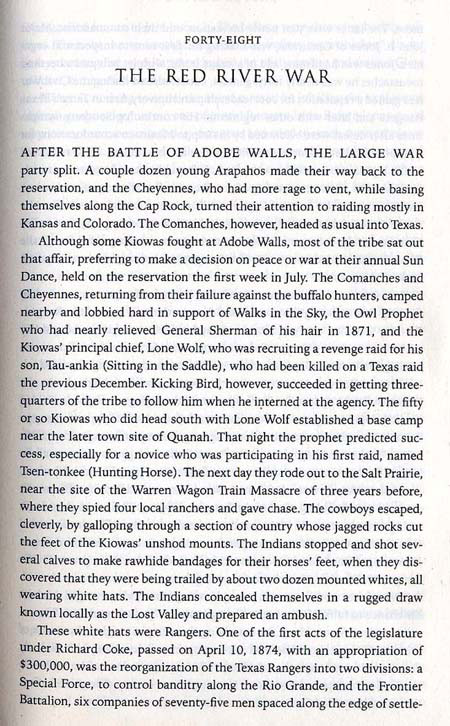
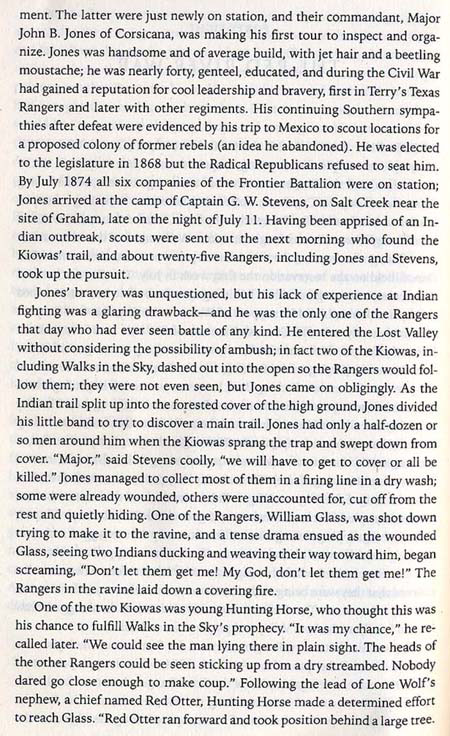
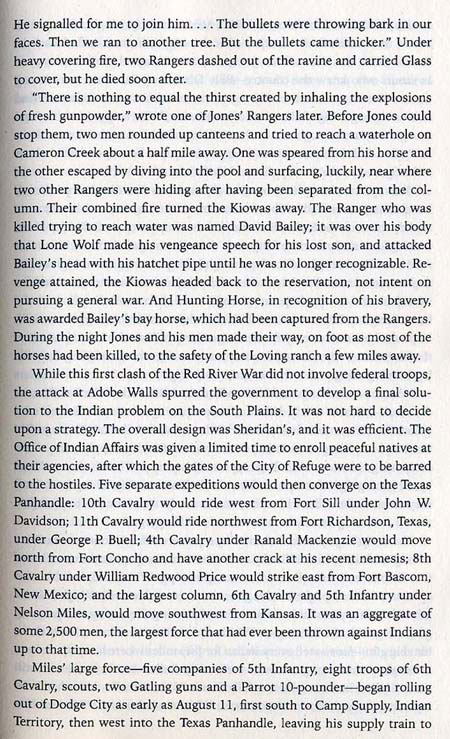
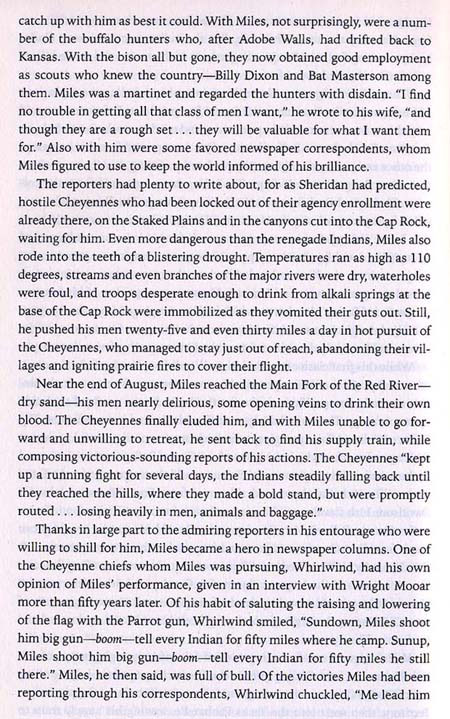
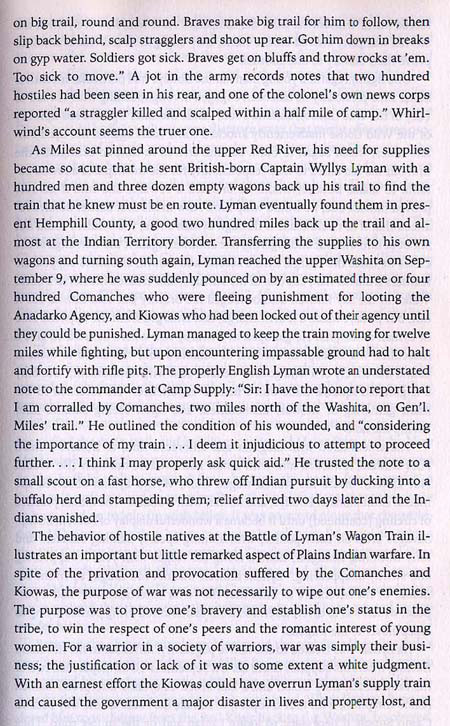
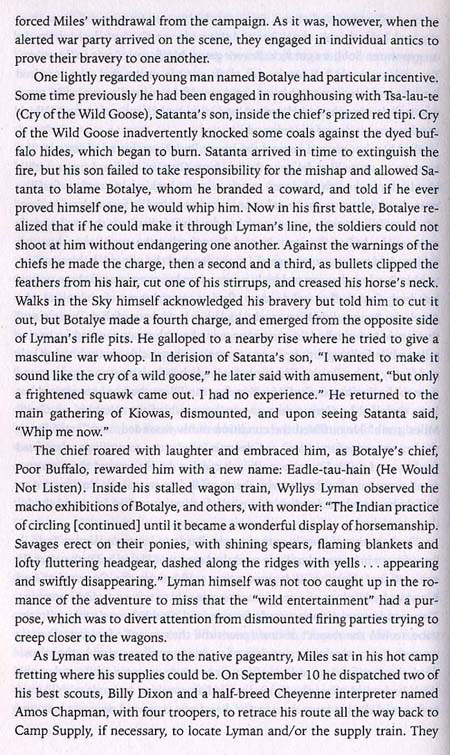
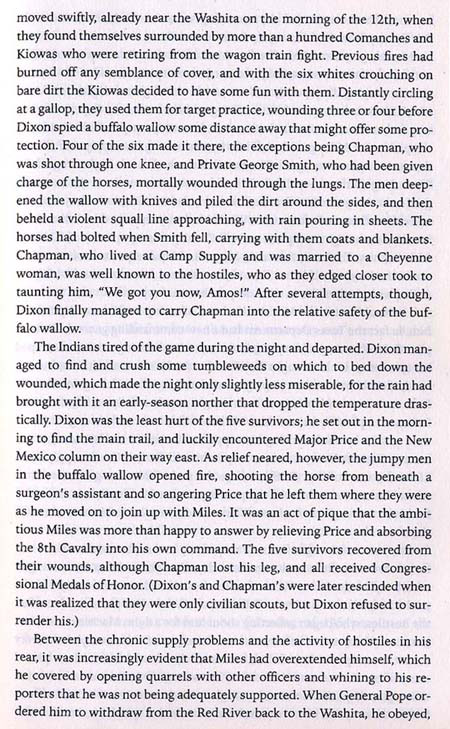
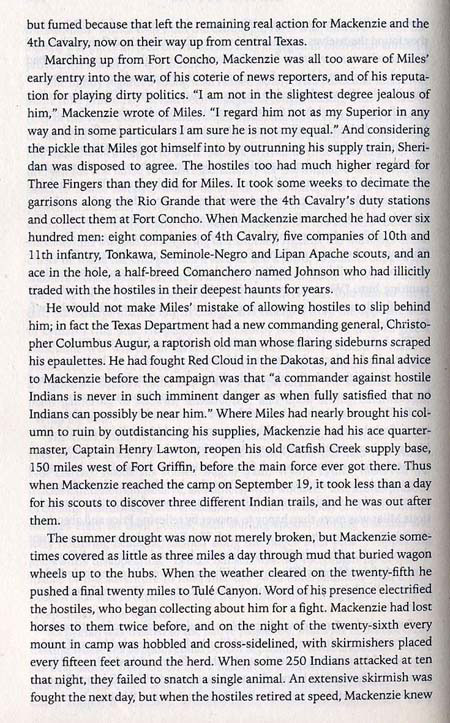
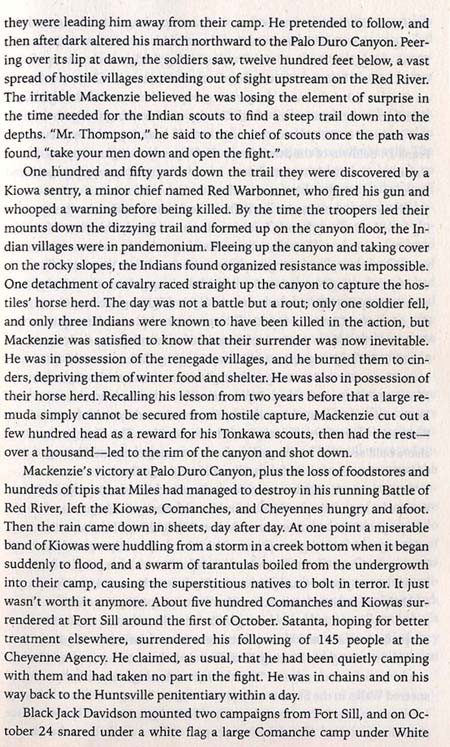
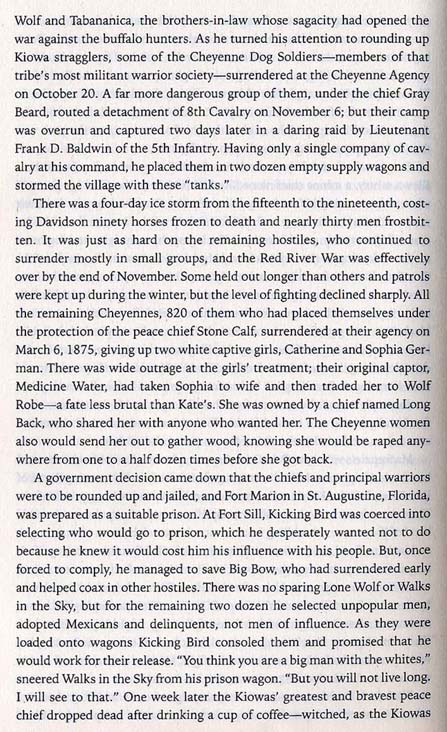
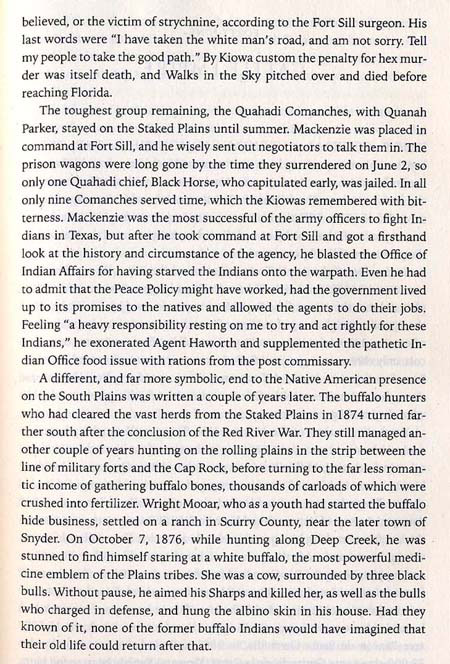
|
